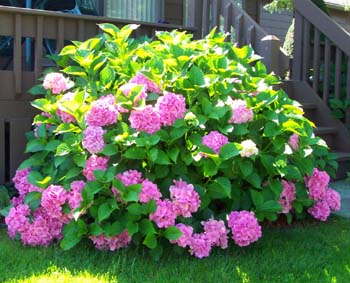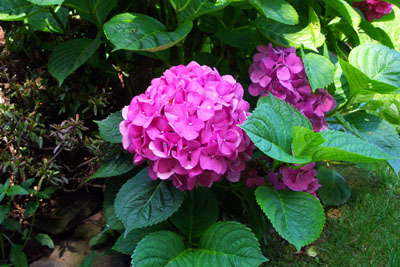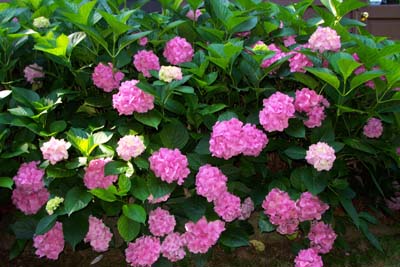






Perennial Shrub
Hydrangea are beautiful, perennial bushes with huge flower heads. These deciduous bushes profusely produce huge, round flower heads in mid-summer. Hydrangea are native to North and South America, Himalayas, and central and eastern Asia.
Colors include white, pink, blue lilac, purple, varying shades of these colors, and a variety of two tones.
Flower heads have two kinds of florets Sterile, or ray florets, are male and form the large, colorful sepals on the outside of the flower head. The fertile florets bear the male and female parts, and are usually found in the center of the cluster.
During the spring through fall, these bushes have attractive foliage. Most varieties of Hydrangea grow from 3 to over 10 ft. tall. Some varieties grow up to 25 feet. Most varieties prefer full sun to partial shade.
Perhaps the only downside to these lush plants with their colorful blooms, is that they shed their leaves the fall. The leafless bush becomes a less than attractive clump of stalks and stems until the following spring.
Did you know? There are over 1200 species of Hydrangeas.
Plant Propagation:
Hydrangeas are grown from cuttings. Start new cuttings from April through August. Select new growth and cut about 6" to 8" from the the end of non-flowering stems. The cutting should have two to three pairs of leaves. Remove the bottom pair of leaves. Plant them in sandy soil in a shady location.Cover the cutting with a glass jar or other clear cover until the roots form. Keep the soil moist.
Once roots have formed, the new plants can be transplanted to their new location in your garden or in containers.
Hydrangeas can also be propagated by harvesting the seeds.
How to Grow Hydrangea Bushes:

Hydrangea bushes are easy to grow. They prefer full sun to partial shade. In warmer climates, put them in a more shaded area, to reduce wilting in the midday sun. They prefer moist, rich, loam soil that drains well.
When planting, add generous amounts of rich compost. Add mulch yearly to help retain soil moisture, and to replenish nutrients for the plants. Keep the soil moist the entire season to promote lush growth and big blooms. Add a general purpose fertilizer monthly.
Flowers will begin to bloom in mid summer. Remove spent blooms. This will promote more blooms. To grow bigger blooms, thin some of the stems.
Prune bushes back in winter to early spring. If the bushes become too big or winter damaged, they can be cut back close to the ground.
Color Me Hydrangea:
They say a leopard can't change his spots. But, a Hydrangea can change it's colors. Some varieties will change flower colors, depending upon the soil condition.
The amount of the micro-nutrient aluminum available for uptake by the plant results in the color changes. The pH level influences the ability of the plant to intake and use this micro-nutrient. In acidic soils high in aluminum, the flowers are blue. The higher the acidity(and aluminum), the bluer the flower. Neutral soils with less aluminum are white. Alkaline soils result in pink blooms.
To change flower colors:
Add lime of the soil to reduce acidity
Add Aluminum sulfate to increase acidity.
No Blooms? The most common cause is winter damage. A frost will kill the buds. Too much shade and poor soil conditions can also result in no blooms.

Insects and Disease:
Aphids, red spiders and a few other insects can be an occasional problem. Treat with mild insecticides or insecticidal soaps.
Powdery Mildew, blights and leaf spots can occur. Treat plant as needed with a fungicide.
Coneflowers: How to Plant, Grow, and Care for Coneflowers
Cosmos: How to Plant, Grow, and Care for Cosmos
Impatiens: How to Plant, Grow, and Care for Impatiens
Petunias: How to Plant, Grow, and Care for Petunias
Yarrow: How to Plant, Grow, and Care for Yarrow
Copyright © www.100flowers.win Botanic Garden All Rights Reserved